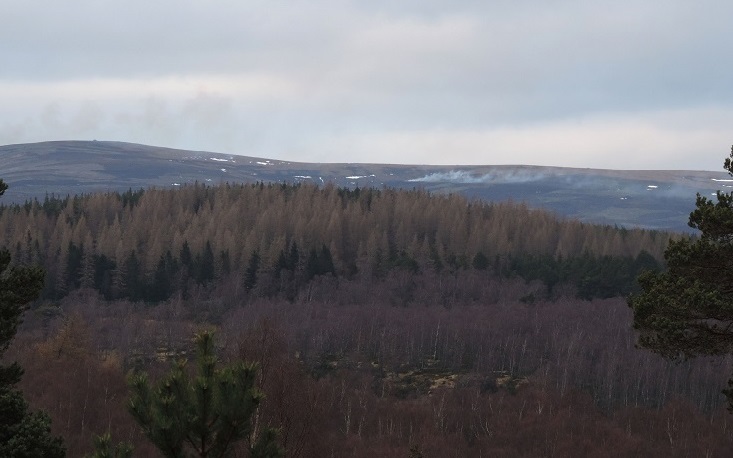
Following my post Fires, hypocrisy and access rights in which I had described seeing a wall of fire as I crossed over Slochd into the Cairngorms National Park, a reader sent me a couple of photos they had taken the same day. The photo featured above is looking over to Slochd from the south: if you look carefully you can see a second plume of smoke on the left of the photo which appears to have been caused by the fire I witnessed.
The second photo is of a fire not far outside the Cairngorms National Park boundary:
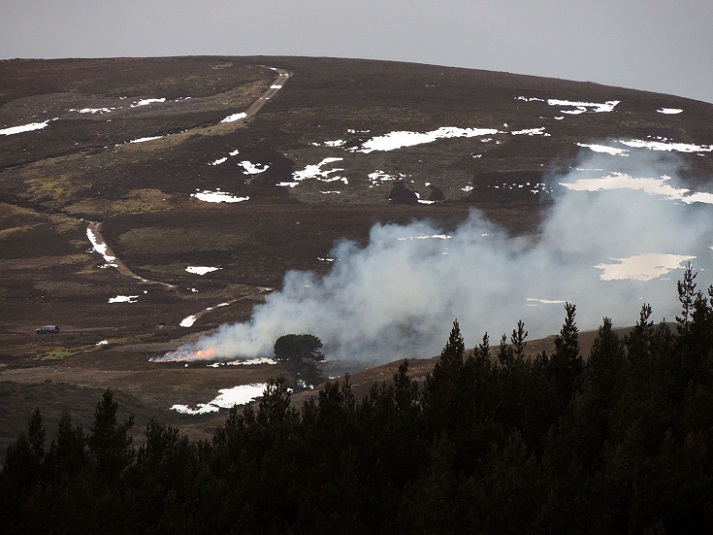
All three fires appear to have been lit on the Seafield Estate:
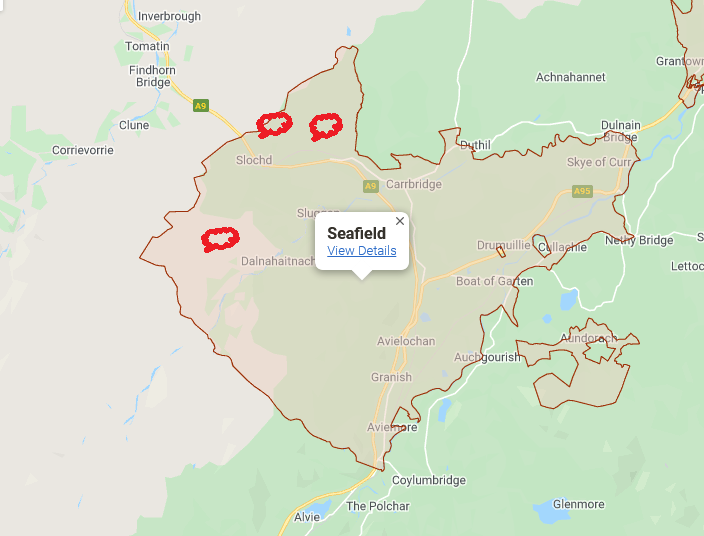
That the Seafield Estate is still allowing muirburn to be carried out on its land is very disappointing:.
“Heather is also an important resource and, while grouse shooting is less of an economic driver for the Estate now than in previous years, considerable planning and manpower is still required to retain and promote heather growth, and burning and cutting are important aspects of today’s moorland management.” (see here)
On the one hand the estate appears to be trying hard to bring down deer numbers on the River Dulnain, so that the Caledonian Pine Forest along the river is now regenerating, and is heavily involved in the Cairngorms Capercaillie Project, set up to help prevent that bird become extinct. But on the other hand the estate continues to allow land it owns – some may be leased out – to be burned. This effectively prevents the Caledonian Pine Forest from expanding again, when what species like the capercaillie need is more habitat.
As for Slochd, I came across this in Ecology and Land Use in Upland Scotland, the textbook for radical ecologists in Scotland 50 years ago:
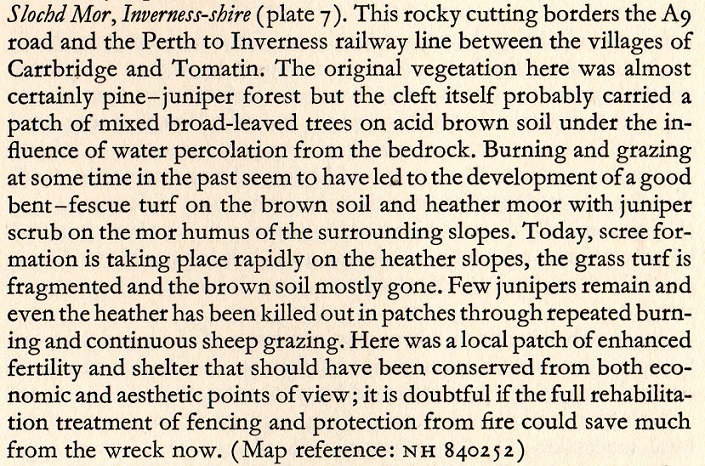
Slochd might well have been designated a Site of Special Scientific Interest in the 1970s if it had not been so trashed by muirburn. Nothing has changed in 50 years and still we allow the current capitalist system – which sets the context for all land management – to march on destroying nature and the climate before it. I am, however, more optimistic than McVean and Lockie: if we stopped muirburn and brought deer numbers down, places like the Slochd could recover and become special again. The challenge is how we finance this.
In his foreword to the most recent Seafield and Strathspey Estates newsletter (see here), Lord Seafield gets the connection between how primary land-use activities both contribute to climate change and are affected by it. But while mentioning agriculture and forestry, and acknowledging the devastating impacts that storm and drought can have on these activities, he is silent on grouse moor management.
While, as Lord Seafield points out in his article, almost 30% of the Strathspey Estate’s land is covered in forest, managed both commercially and for nature, the estate website (see here) shows even more is managed as grouse moor:
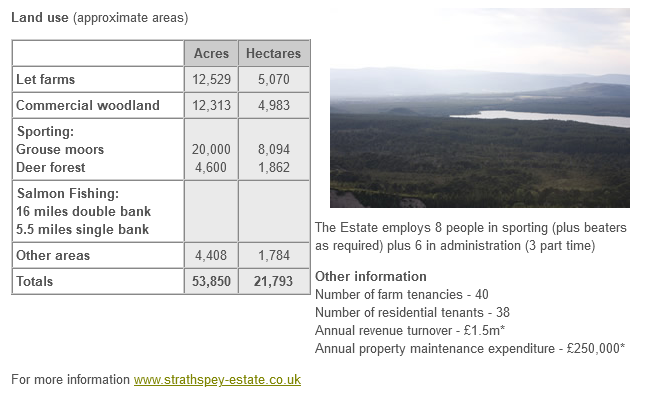
To give Seafield Estates credit, the extent of woodland cover on their land far exceeds the measly 23% which the Cairngorms National Park Authority set as its target in its draft National Park Partnership Plan (see here), even if it’s still well below the European average of 38%. If Seafield stopped the muirburn and controlled the deer, they could probably reach European levels of woodland cover in 20 years. The problem, however, is finance as the estate website suggests:
“The sporting operations, including grouse moors, are managed entirely commercially rather than for the benefit of the proprietor.
Sporting shooting is labour intensive. While revenue comes from only a few days sport, there is a continual programme of vermin control and moor maintenance. The sport is expensive to supply and operate but it enables essential essential land management to be financed and helps maintain our beautiful Scottish uplands. Shooting supports rural families and jobs and brings considerable foreign currency into the local economy. Shooting sports receive no subsidy from the EU or the UK Treasury.”
To put it another way, the estate employs significant number of people to destroy wildlife – “vermin” – and burn the land because this brings in income which not only supports other estate activities but helps the local economy. Where I disagree with the estate is that muirburn keeps the uplands beautiful: land denuded of nature is in my view ugly. But whatever the arguments about aesthetics, the finances are bonkers. We are allowing large areas of land to be destroyed ecologically in order to finance conservation land-use in other areas.
Estates like Seafield, which in my view are partly trying to do the right thing, will never be able to resolve these contradictions on their own. Unlike Wild Land Ltd at Glen Feshie, which is doing the right thing, or the Royal Family on Deeside, which isn’t (see here), they are not owned by people who are extremely wealthy. Both Anders Povlsen and Prince Charles have access to stashes of cash and can do what they want, the one good, the other bad. If we want to change land-management on estates like Seafield, we have to change the current subsidy system for land-management in Scotland so that it enables such estates to do the right thing for the climate and for nature.
In my view, Scotland’s National Parks should be leading the way on this, which is why the Cairngorms National Park Partnership Plan is so disappointing. It contains not a single practical proposal that will enable and support estates like Seafield to change.
While that will require more public investment, much of this could come from re-directing forestry and agricultural subsidies which are currently being wasted. For example, at the end of last week I received the consultation documents for the first stage of BrewDog’s Lost Forest at Kinrara (which borders Seafield’s land at Kinveachy). It includes proposals for extensive new deer fencing and the mounding of peaty soils to plant trees ) – funded by public subsidy – when if BrewDog reduced deer numbers, the forest would regenerate naturally (more about this soon). Perhaps the Cairngorms National Park Authority (CNPA), which does state in its draft National Park Partnership Plan that its preference is for woodland to expand by natural regeneration, could take the opportunity to propose an alternative to the current forestry subsidy system?
Unfortunately, the CNPA appears unlikely to do this when it has so many conservative land-management interests on its Board and when conservation organisations remain so silent about damaging practices like muirburn. Last week, the latest John Muir Trust newsletter dropped through my letterbox and I was disappointed but not that surprised to read the following statement under “Latest Consultation Responses” [UPDATE: NB see comment below from Mike Daniels of JMT]
“we also contributed to the Cairngorms National Park Partnership Plan draft and welcome it as a bold and ambitious plan for nature’s recovery in the Cairngorms National Park”.
Really? 23% woodland cover by 2045 and limited proposals to end muirburn on peat over 50cm deep, ambitious?
JMT’s Board should read McVean and Lockie and in my view their members need to pressurise JMT as an organisation to start taking a more radical stance about land-use. Sadly, many of the landowning NGOs in Scotland seem as incapable of challenging the current system, which is destroying nature and releasing carbon into the atmosphere, as traditional landowners. And like our public agencies, as I will come back to in my next post, many NGOs are devoting far more effort to trying to stop visitors to the countryside from lighting fires – a small issue in the scheme of things – than they do to trying to stop muirburn and change the public subsidy system to support that.
Scotland will NEVER learn how to properly manage deer populations by culling, as other countries do, while our regulatory systems and financial incentives remain as they have always been – primarily designed to satisfy landowning, not public interests. We will not secure the essential landscape sale ecological restoration while public bodies, NGOs and the financial predators now taking control of our hills continue to support deer fencing and tree planting. And we, the taxpayers, are paying for all this nonsense to help fill the pockets of people from far away places! The latest plans published for Brewdog’s estate near Aviemore demonstrate all that is wrong with the current system. Paying public money to Brewdog to erect deer fences is absurd when the alternative, to employ more local stalkers to cull the deer would be cheaper and far more effective in securing the natural regeneration of the ancient Caledonian forest.
Far too much land in the hands of a tiny minority. It still smacks of the 19th century when Queen Victoria bought Balmoral and set a precedent with all the other aristocratics buying estates for a few weeks “fun”. And our present monarch has done little to change the above estate, if she had done and set an example maybe there would have been real changes.
Well the SNP Judas Brits in Kilts have promised to paint the sky tartan and give Scotland back to the Scots. But if you believe that you will believe anything. And don’t tell me about Labour RIP. That’s another dead parrot that never got off the ground. George Galloway is back living in Scotland with the Workers’ Party. I’m going to join them. Any luck and we might even get to postpone WW3.
The Slochd,……. its just Slochd…. there is no The.
Thanks for the correction, I have not done too well in this and the previous post, Assynt for Coigach and now the before Slochd, will fix both, Nick
Meaningful change requires, at the very least, a payments system that compares favourably with the net income , on a rolling five or ten year period, for any given grouse moor / deer forest.
Anything less would require legislation to ensure uptake, and could result, in many instances, in the destruction of communities as can be seen at Kinrara, and a reduction in incomes for surrounding businesses.
Shooting parties will move from moor to moor throughout the season, and make repeat visits year on year.
Only a select number of estates can successfuly make the switch to nature based enterprises, before the market becomes saturated.
The argument that field sports and shooting “industry” somehow preserves communities in the more remote parts of Scotland is now seen as so much self interested “puff” by more informed people in many quarters. The truth on display over the past 2 decades shows that fields sports as the sole means to provide employment in remoter places, is far from the case. With the advent of the internet satellite phones and now G4 masts huge numbers of older properties have been snapped up across the highlands, by those from more affluent distant places. Used only occasionally by those who purchased them, a majority are now sub let for many weeks each year. This practice destroys rural year-round communities . The slide can be seen as generating wealth only for national marketing platforms and for property owners to spend far away.
Moves to ensure a full local authority register is kept, with annual licensing of all holiday lets, may help address some of the downsides. Yet, one vital fact is not at issue. Each and everyone of these, now remotely-owned properties. still requires routine maintenance. Weekly let holiday homes require cleaners, plumbers, gardeners, equipment inspectors. gas certification, heating system repairers, water supply and drainage contractors etc…just to keep the houses in good order. Friendly faces are needed to welcome guests, provide informed local holiday advice, and also to restore good order once the “transients” have gone.
The real issue is how to preserve any traditional community in the face of galloping property prices, fueled far away. The current situation leaves offspring of long standing local people unable to afford to remain in their traditional locality. Despite successive generations of their forebears, once qualified, the option to return to provide the maintenance for properties,which they are themselves unable to afford, has for these younger adults become impossible. . Any solution to this conundrum is eagerly sought.
Even without eradicating muirburn and no longer having to put up with invasions of visitors who come infrequently for private , and rather selfishly exclusive leisure field sports, the requirement for locally based property service crews to address the needs of all transient holiday makers will still exist. Communities that survive the current property price trend can still “tap into” vast spending power brought by those on holiday, by providing such things as property services, leisure clothing, souvenirs, bikes and boats for hire? These employment opportunities clearly exist. It is affordable property that is vanishing.
Thanks Nick
In fact if you read the JMT response
(https://www.johnmuirtrust.org/assets/000/002/042/Final_JMT_Response_-_Cairngorms_National_Park_Partnership_Plan_2022-2027_original.pdf?1641573515)
it states:
“We support and endorse the general direction of the plan and its identified priorities, and we very
much welcome the importance placed on addressing the twin biodiversity and climate crisis. We
would, however, encourage the Cairngorms National Park to push for ambition. In the context of the
nature and climate emergency, we need to set progressive targets in order to halt climate change
and reverse the loss of biodiversity. The Cairngorms National Park has a unique opportunity to
establish itself as a leader and an exemplar in delivering effective action and demonstrating how
progress can be made. Positive action also has the potential to deliver sustainable and high-quality
jobs, as well as building resilient communities, which provides a strong mandate for upping ambition
and increasing the speed of change.”
and
“we strongly maintain that the deer density target needs to be
lowered to 2-3 per square kilometre, rather than the stated 5-8 per square kilometre. At the very
least, the density target needs to be under 5 per square kilometre if we are to enable significant
natural regeneration and the expansion of native woodland. We recognise that red deer are a
natural part of the National Park, but at high densities they can have severely detrimental impacts
on vegetation, including tree regeneration, peatlands and other sensitive habitats. We therefore
urge the National Park to set a more ambitious target for the reduction of deer numbers. With
ambitious deer management targets, there will need to be more skilled stalkers in the National
Park, which would create job opportunities for local communities. ”
and
“We strongly support the peatland restoration target, which is also an opportunity for both skills
development and job creation within the National Park. We would, however, urge the National Park
to increase its target area for restoration, given that 15% of Scotland’s peatlands are located within
the park. The target to restore a minimum of 6,500ha within the next 5 years is a minor increase
from the 5,000ha target in the previous park plan from 2017-2022, and we would therefore urge the
National Park to be more ambitious. Increasing the target would also help the National Park realise
its aim to become net zero and carbon negative before 2045. ”
and
“…We would, however, emphasise that all
muirburn should require licensing, including burning for agricultural purposes, and that this should
be clearly set out in the plan.”
Thanks Mike, this is very good news – and is similar to what I have been arguing in my posts on parkswatch. I must say I was taken aback to read what was in the newsletter – the perils of trying to summarise a response in one sentence! Nick